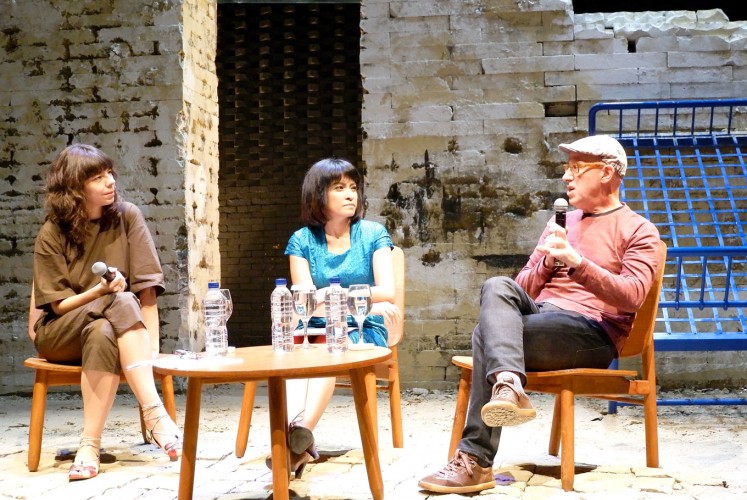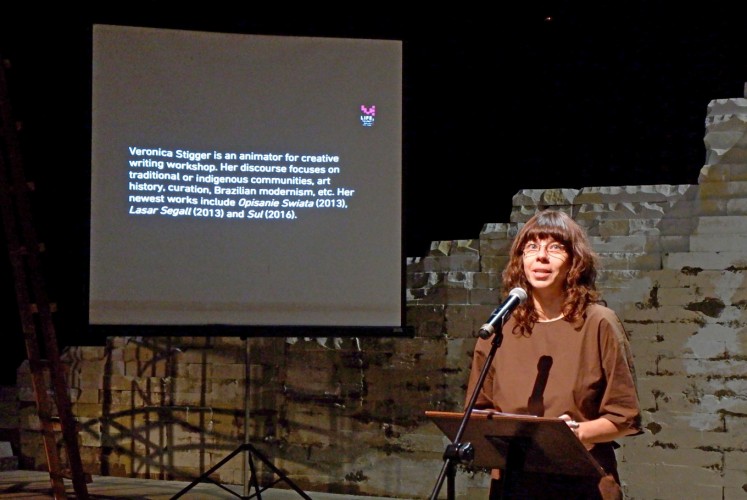Popular Reads
Top Results
Can't find what you're looking for?
View all search resultsPopular Reads
Top Results
Can't find what you're looking for?
View all search resultsReading Latin America
Latin American literature is celebrated at Salihara Theater in South Jakarta.
Change text size
Gift Premium Articles
to Anyone
I
ndonesia is oceans away from Latin America, but it does not take long to fall in love with the products of their culture — from dancing to films, from music to food, as seen during the Sajian dari Selatan (Treats from the South) event at the Salihara Theater in South Jakarta.
But the event is not about Latin American food or dancing. It was a discussion on literary works by five renowned Latin-American writers — Argentinean Sergio Chejfec, Colombian Héctor Abad, Mexican Carmen Boullosa and Brazilians Veronica Stigger and Victor Heringer. They were in Jakarta on their way to the Ubud Writers & Readers Festival in Bali, which ran from Oct. 25 to 29.
Hosted by Indonesian writers Feby Indirani and Nirwan Dewanto, the discussion was part of the Literature and Ideas Festival (LIFEs) held by the Salihara Community with theme “Viva! Reborn!” from Oct. 7 to 28.
“If we divide literary works by countries, regions or languages, those from Latin America are the most in-demand in Indonesia. Indonesian readers love Latin America. In this country, the number of translated books from that region is highest [compared to that of other regions],” said the festival’s director Ayu Utami.
Read also: Latin America literature celebrated at Salihara festival
For example, many translated books that explain dependency theory, echoed by Argentine Raul Prebisch, Brazilian Fernando Cardoso and Chilean Enzo Faletto, circulate in the country. It explains the failure of developing countries, including Indonesia, to grow economically in spite of investment from developed country.
For a writer, inspiration can come from many places, including from the history of his or her country.
When it comes to history, Indonesia and Latin America have much in common. They not only have similar experiences with colonization, but they also suffered similarly during the Cold War and were once under military regimes.
Listen up: Brazilian Veronica Stigger (left), Feby Indirani (center) and Argentinean Sergio Chejfec talk about Latin American literature at the Salihara Theater in Jakarta. (JP/A. Kurniawan Ulung)During Sajian dari Selatan, Abad recalled his father, a doctor and human rights leader who was murdered by paramilitaries in 1987 for fighting against oppression and social inequality in Colombia.
For him, the tragedy was hard to face and steered him away from writing about violence.
“The first violence I saw was the moment when my bike was stolen while I was at my girlfriend’s house,” he said, laughing. “I liked to write books about happiness, love and sex.”
However, he changed his mind when he noticed that paramilitaries began to write memoirs as a way to justify their actions.
“Twenty years after the assassination of my father, I understood that I had to write about it. I had to write about his beautiful life. He was a very lovely person,” he said.
In 2006, Abad, who is considered one of the most talented writers of the post-Latin American Boom in Latin American literature, published El Olvido que Seremos (Oblivion: A Memoir), through which he opened up about his loss and depicted his father as a symbol of the ongoing fight against injustice.
Unlike Abad, Stigger and Feby talked about the rise of conservative groups in Brazil and Indonesia.
During the event, Stigger read her poem, The Heart of Men, which talks of women’s menstrual cycle. The work is part of her latest book, Sul.
Stigger explained that she likes to write literature about blood because it represented the state of affairs in Brazil, which is full of conflict and has a long history of violence.
Although The Heart of Men does not explicitly mention violence, the word “blood,” mentioned in the poem, is an allusion to violence, she added.
Stigger said that today in Brazil, freedom of expression was under threat from conservative groups, who do not hesitate to commit acts of violence. In September, for example, the Santander Cultural Center had to cancel the Queermuseu exhibition in Porto Alegre, which explored sexual diversity, following a campaign by right-wing protesters.
Veronica Stigger (JP/A. Kurniawan Ulung)The queer art exhibition was accused of promoting blasphemy, pedophilia and bestiality.
Similar concerns were also raised by Feby, who was afraid that Indonesia was becoming more conservative, especially after former Jakarta governor Basuki “Ahok” Tjahaja Purnama was imprisoned for blasphemy.
During Sajian dari Selatan, Feby read her short story, Ruang Tunggu (Waiting Room), which is part of her new anthology Bukan Perawan Maria (Not the Virgin Maria).
Through the book, Feby wants people to have more empathy and be more tolerant and open-minded. “I wonder why many people are fighting and acting violently in the name of Islam, which actually promotes peace,” she said.
At LIFEs, there is another exhibition called Xalisco Performative Exhibition: Juan Preciado, which visualizes the award-winning novel, Pedro P'ramo, by Juan Rulfo, a Mexican writer who won Mexico’s National Prize for Literature in 1970.
First published in 1955, Pedro P'ramo was inspired by Rulfo’s true story. When the violence raged on the Mexican countryside into the late 1920s, thousands of peasants, including his mother and father, were killed. On Oct. 8, publisher Gramedia Pustaka Utama launched its translated version.
Regarded as one of the most popular pieces of classic Mexican literature, Pedro P'ramo tells the story of Juan Preciado, who promises his dying mother that he would visit her hometown of Comala to search for his father, Pedro Paramo.
To give life to the novel, the exhibition displayed many interesting objects, such as a white bed frame that represents where Preciado’s sick mother laid and delivered her last words to her son, and stained shirts, which represent what he wore during the events.
For the exhibition, Ines Somellera, the Mexican artistic platform director for art projects at Empu Sendok Arts Station (ESAS), collaborated with Depok-based artist Hanafi.
Hanafi said he was amazed by the beauty of Pedro P'ramo. He hoped that after enjoying his exhibition, visitors would be interested in reading the novel.
“This exhibition also aims to celebrate the 100th anniversary of Juan Rulfo,” he said.













